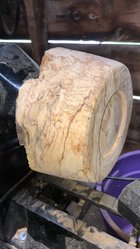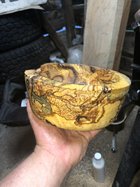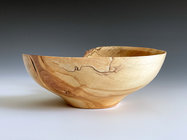-
Congratulations to Rick Moreton, People's Choice in the July 2025 Turning Challenge (click here for details) -
Congratulations to Jaramiah Severns for "Stacked Forms II" being selected as Turning of the Week for August 4, 2025 (click here for details) -
Welcome new registering member. Your username must be your real First and Last name (for example: John Doe). "Screen names" and "handles" are not allowed and your registration will be deleted if you don't use your real name. Also, do not use all caps nor all lower case.
You are using an out of date browser. It may not display this or other websites correctly.
You should upgrade or use an alternative browser.
You should upgrade or use an alternative browser.
What kind of wood
- Thread starter Sheldon Gerber
- Start date
- Joined
- Jan 27, 2005
- Messages
- 13,135
- Likes
- 5,630
- Location
- Dalworthington Gardens, TX
- Website
- pbase.com
What kind of wood is it? Most definitely, it's very punky spalted stump wood.  Beyond that, it's very difficult to ID wood from a picture even when it is in pristine condition. When the wood is very punky and spalted it is practically impossible. If you want to make an educated guess about the species, if the wood came from somebody's yard that would be the easiest solution. Otherwise, the most common species in your area would be the most likely suspects and might be the best that you would be able to determine.
Beyond that, it's very difficult to ID wood from a picture even when it is in pristine condition. When the wood is very punky and spalted it is practically impossible. If you want to make an educated guess about the species, if the wood came from somebody's yard that would be the easiest solution. Otherwise, the most common species in your area would be the most likely suspects and might be the best that you would be able to determine.
If you want to do some research, the best reference that I know of is, "Identifying Wood" by R. Bruce Hoadley. He says that wood can be identified by closely examining the end grain growth rings and pores. A good magnifying glass, pocket microscope, or if you have a camera with a macro lens that would be very useful in helping you ID the species. If the wood is very rotten you might not be able to positively identify it, but you might be able to make an educated guess.
Before you do the finish turning, it would help immensely if the wood were fortified by soaking in thinned shellac or lacquer and then allowed to thoroughly dry. To minimize the chance of tear out I would recommend a very finely honed bowl gouge and take very light shear cuts (handle dropped very low (about 45°), bevel lightly gliding. If that doesn't work try shear scraping.
If you want to do some research, the best reference that I know of is, "Identifying Wood" by R. Bruce Hoadley. He says that wood can be identified by closely examining the end grain growth rings and pores. A good magnifying glass, pocket microscope, or if you have a camera with a macro lens that would be very useful in helping you ID the species. If the wood is very rotten you might not be able to positively identify it, but you might be able to make an educated guess.
Before you do the finish turning, it would help immensely if the wood were fortified by soaking in thinned shellac or lacquer and then allowed to thoroughly dry. To minimize the chance of tear out I would recommend a very finely honed bowl gouge and take very light shear cuts (handle dropped very low (about 45°), bevel lightly gliding. If that doesn't work try shear scraping.
Personally I wouldn't call that second one finished. Those rows of tear out would have greatly benefitted from wood stabilizer and abrasive work vs what ever tool you were using. When there is no natural color left in the wood, and no leaves or bark for identification, species can't be accurately done.
Hard to tell, but first guess would be birch as there is a fair amount of that up your way. Silver maple would be another guess.
robo hippy
robo hippy



